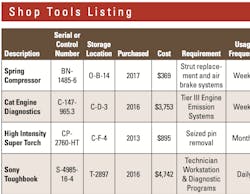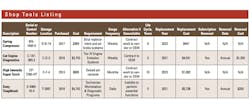How to Build a List of Maintenance Shop Tools
Equipment maintenance functions require the use of specialized tools at varying intervals, and their availability to technicians should be simplistic yet structured, allowing for proper management and control. Identifying specialty tools required—as well as managing their acquisition, storage location, utilization control, and funding—is often a much larger task than anticipated.
Shop tools should not be confused with general service personal tools supplied by the technician, such as handheld sockets, or larger items normally designated as shop equipment, such as lifts and drill presses. Shop tools exceed the technician tool requirement due to size, complexity, or cost.
A listing of shop tools documents and validates the requirements, and also assists with budgeting for their replacement.
Shop tools must be managed by shop supervision and made readily available to technicians so as not to increase labor effort or downtime. Proactive equipment managers understand their shop tool requirements and develop a documented, systematic approach to identify and manage the required tools. This maintains the high levels of productivity required of the shop. A detailed listing of all shop tools should be developed and maintained to document and validate the shop tool requirement as well as assist with budgeting their replacement.
Shop tools represent a sizeable investment, and the management and control of shop tools should be defined by written policy to ensure knowledge and compliance requirements. Such policy should address the storage location, requirement and usage documentation, acquisition authorization, and inventory and inspection intervals.
The first step in developing a system is to define “shop tool.” Shop tools generally are highly specialized and are required to complete highly specific tasks on specific equipment or a specific system on equipment. Examples include handheld individual pieces or sets of varying size pieces, specialized diagnostic scanners, electronic equipment, or large tools required to perform highly technical maintenance and repair functions or sequences. They differ from shop equipment, which is normally a larger piece of equipment or a series of individualized pieces that perform a specific shop function and are often in a stationary or fixed location within the facility.
Identification of specific shop tools must include a rationale for how often they are required. Technicians could be left without the tools, or they could sit in a corner collecting dust. Emphasis should be placed upon supporting primary/critical equipment, as approximately 60 percent of shop tools are required for this asset category. Secondary/associated equipment would be next, followed by miscellaneous equipment and administrative/support equipment. Advanced technology equipment tools required should be listed and maintained separately as it is unlikely they could be utilized on other equipment categories.
Click for more asset management.
Authorization for the acquisition of shop tools should be held at the shop superintendent level to validate the need, identify the storage location, and document the acquisition. Tool rooms, areas, carts, or shadow boards should be kept clean and well-organized with specific locations identified for each tool. Shop tools should not be modified by technicians, and tools with wear points should be inspected on a regular basis. Any modified tool or tool showing signs of excessive wear should be removed from use, tagged as “Do Not Use,” and repaired or replaced once the continuing requirement is revalidated.
Many shop tools require specific training on their proper use. All technical electronic diagnostic programs and their delivery platforms require training and familiarization to ensure accuracy of use. Many specialty shop tools require PPE and safety training to identify specific hazards. All such training should be documented, and safety training related to such tools should be incorporated into the organization’s continuing safety training curriculum.
Each maintenance facility should have a detailed listing of shop tools on hand, including item description, serial number or inventory control number, storage location, year purchased, cost, requirement for the tool, frequency of use, alternative if unavailable, life cycle, replacement date, replacement cost, and if applicable, subscription renewal, date, and cost. Frequently utilized tools that require multiple units in inventory should be listed separately to quantify the need and identify the replacement and justification information separately.
Tool description, serial or control number, purchased date, and cost are all fixed values and are available upon acquisition or from the acquisition documentation.
Storage locations for shop tools require consideration of location and availability, and the location code should identify location and bin or shelf. Shop tools valued at or below a specified value having minimal inherent safety concerns should be located in an open tool area (Location code = O) that is easily accessible by all technicians and floor supervision. Shop tools valued above the specified value or those that pose potential safety concerns should be located in a controlled or limited-access area (Location code = C). Shop tools specifically assigned to a technician should be identified as located with the technician (Location code = T “2897”).
A brief statement documenting the tool requirement on the listing becomes valuable information when reviewing budget with senior management and when replacement decisions are made.
Frequency of use should be monitored. Frequency of use assists with justification for inventorying the tool and can be monitored through a simple sign-out sheet. Some organizations use a “chit” system; others utilize an advanced bar code or QR code system. Technician compliance becomes the key factor in identification of usage, which should be relayed and monitored by supervision.
Understanding alternatives if the specific tool becomes unavailable assists in justification for the tool as well as establishing the criticality of maintaining the tool in inventory.
The life cycle of the tool, as well as the anticipated replacement year and cost, should be documented. This assists with budgeting and becomes invaluable information in the unlikely event an insurance claim is required to replace some or all the facility’s shop tools.
Diagnostic software, scanning tools, and their electronic platforms normally require periodic subscription renewals or upgrades. Such upgrades and renewals should be documented on the listing as well as the date of renewal or upgrade, and cost. This assists with budgeting and ensuring the latest diagnostic information is available to the technicians.
Additional shop tools acquired after completion of the listing should be added immediately upon arrival at the facility. Similarly, shop tools no longer required should be removed from the listing upon disposition. Periodic updates other than additions and deletions are only required to document the changing frequency of use, normally semi-annually or annually.
A detailed listing allows for a comprehensive review of shop tools. Budgeting accuracy increases as the list can be sorted by replacement year for future year forecasting with justification for the funding well documented, and the replacement or depreciated value is readily available if needed.

